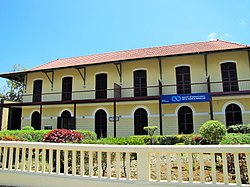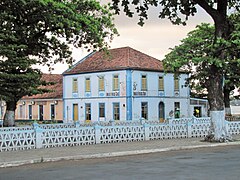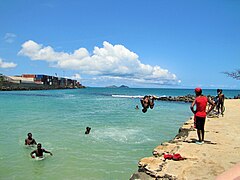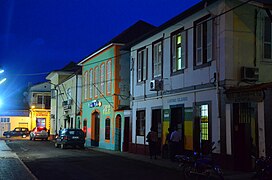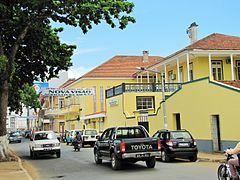São Tomé
São Tomé | |
|---|---|
City | |
(from top: left to right) Downtown São Tomé, Port of Sao Tome, Ana Chaves Bay and Bank International of Sao Tome. | |
Location on São Tomé Island | |
| Coordinates: 0°20′10″N 6°43′50″E / 0.33611°N 6.73056°E | |
| Country | |
| Island | São Tomé |
| District | Água Grande |
| Founded | 1485 |
| Named for | Thomas the Apostle |
| Area | |
| • Total | 17 km2 (7 sq mi) |
| Elevation | 137 m (449 ft) |
| Population (2015 estimate) | |
| • Total | 71,868 |
| • Density | 4,200/km2 (11,000/sq mi) |
| Time zone | UTC+0 (GMT) |
| Area code | +239-11x-xxxx through 14x-xxxx |
São Tomé is the capital and largest city of the Central African island country of São Tomé and Príncipe. Its name is Portuguese for "Saint Thomas". Founded in the 15th century, it is one of Africa's oldest colonial cities.[1]
History
Álvaro Caminha founded the colony of São Tomé in 1493. The Portuguese came to São Tomé in search of land to grow sugarcane. The island was uninhabited before the arrival of the Portuguese sometime around 1470. São Tomé, situated about 40 kilometres (25 mi) north of the equator, had a climate wet enough to grow sugarcane in wild abundance. In 1497, 2,000 Jewish children, eight years old and under, were taken from the Iberian peninsula, to receive catholic education, following the national policy of conversion to Catholicism.[2] The nearby African Kingdom of Kongo eventually became a source of slave labor as well. The island of São Tomé was the main center of sugar production in the sixteenth century; it was overtaken by Brazil by 1600.[3]
São Tomé is centred on a sixteenth-century cathedral, that was largely rebuilt in the 19th century. Another early building is Fort São Sebastião, built in 1566 and now the São Tomé National Museum. On July 9, 1595, a slave revolt led by Rei Amador took control of the capital; they were subjugated in 1596.[4] In 1599, the Dutch took the city as well as the islands for two days; they re-occupied it in 1641 for a year. The city served as the capital of the Portuguese colony of São Tomé and Príncipe and, from São Tomé and Príncipe's independence in 1975, as capital of the sovereign nation.[5]
Geography
Important as a port, São Tomé is located on Ana Chaves Bay in the northeast of São Tomé Island, and Ilhéu das Cabras lies nearby offshore. São Tomé is located northeast of Trindade, southeast of Guadalupe and northwest of Santana. It is linked to these towns by a highway which encircles the entire island of São Tomé. It is linked to Cape Verde by a weekly ferry.[6]
Features of the town include the Presidential Palace, the cathedral, and a cinema. The city is also home to schools, and middle schools, high schools, one polytechnic, two markets, three radio stations, the public television station TVSP, several clinics and hospitals, the country's main airport - São Tomé International Airport (with direct regular scheduled flights to Angola, Gabon, Ghana and Portugal as well as occasional domestic flights to Príncipe), and many squares (praças). São Tomé also serves as the centre of the island's road and bus networks The town is well known for the tchiloli playing.[7]
Population history
| Year | Pop. | ±% |
|---|---|---|
| 1990 (June 23, Census) | 42,331 | — |
| 2000 (June 16, Census) | 49,957 | +18.0% |
| 2003 (Estimate) | 53,300 | +6.7% |
| 2018 (July 1, Estimate) | 71,868 | +34.8% |
Transport
São Tomé is served by São Tomé International Airport with regular flights to Europe and other African Countries.
Climate
São Tomé features a tropical wet and dry climate (Köppen As), although it is not far above a semi-arid climate (BSh) due to the influence of the cold Benguela Current, which makes even the wettest months drier than would be expected for such a low latitude but at the same time makes the city very cloudy and foggy even during the almost rainless dry season mid-year. The city has a relatively lengthy wet season from October through May and a short dry season. São Tomé sees on average just under 900 mm (35 in) of rainfall per year. Temperatures in the city are relatively constant, with average high temperatures usually around 30 °C (86 °F) and average low temperatures around 22 °C (71.6 °F).
| Climate data for São Tomé (São Tomé International Airport) | |||||||||||||
|---|---|---|---|---|---|---|---|---|---|---|---|---|---|
| Month | Jan | Feb | Mar | Apr | May | Jun | Jul | Aug | Sep | Oct | Nov | Dec | Year |
| Record high °C (°F) | 32.0 (89.6) |
33.6 (92.5) |
33.5 (92.3) |
33.4 (92.1) |
33.9 (93.0) |
31.0 (87.8) |
30.7 (87.3) |
31.0 (87.8) |
31.7 (89.1) |
31.5 (88.7) |
31.6 (88.9) |
32.0 (89.6) |
33.9 (93.0) |
| Mean daily maximum °C (°F) | 29.4 (84.9) |
29.9 (85.8) |
30.2 (86.4) |
30.1 (86.2) |
29.3 (84.7) |
28.0 (82.4) |
27.3 (81.1) |
27.7 (81.9) |
28.6 (83.5) |
28.7 (83.7) |
29.0 (84.2) |
29.1 (84.4) |
28.9 (84.0) |
| Daily mean °C (°F) | 25.9 (78.6) |
26.2 (79.2) |
26.4 (79.5) |
26.4 (79.5) |
26.0 (78.8) |
24.7 (76.5) |
23.8 (74.8) |
24.1 (75.4) |
25.0 (77.0) |
25.2 (77.4) |
25.5 (77.9) |
25.6 (78.1) |
25.4 (77.7) |
| Mean daily minimum °C (°F) | 22.4 (72.3) |
22.5 (72.5) |
22.6 (72.7) |
22.6 (72.7) |
22.6 (72.7) |
21.4 (70.5) |
20.4 (68.7) |
20.5 (68.9) |
21.3 (70.3) |
21.8 (71.2) |
22.0 (71.6) |
22.1 (71.8) |
21.8 (71.2) |
| Record low °C (°F) | 19.1 (66.4) |
19.6 (67.3) |
19.2 (66.6) |
19.4 (66.9) |
18.5 (65.3) |
14.0 (57.2) |
14.0 (57.2) |
13.4 (56.1) |
16.0 (60.8) |
18.3 (64.9) |
18.8 (65.8) |
19.6 (67.3) |
13.4 (56.1) |
| Average rainfall mm (inches) | 81 (3.2) |
84 (3.3) |
131 (5.2) |
122 (4.8) |
113 (4.4) |
19 (0.7) |
0 (0) |
1 (0.0) |
17 (0.7) |
110 (4.3) |
99 (3.9) |
108 (4.3) |
885 (34.8) |
| Average rainy days (≥ 0.1 mm) | 8 | 8 | 12 | 11 | 10 | 3 | 2 | 3 | 6 | 12 | 11 | 8 | 94 |
| Average relative humidity (%) | 85 | 84 | 83 | 83 | 84 | 79 | 77 | 78 | 79 | 82 | 85 | 85 | 82 |
| Mean monthly sunshine hours | 142.6 | 135.6 | 139.5 | 126.0 | 145.7 | 165.0 | 161.2 | 148.8 | 120.0 | 114.7 | 135.0 | 142.6 | 1,676.7 |
| Mean daily sunshine hours | 4.6 | 4.8 | 4.5 | 4.2 | 4.7 | 5.5 | 5.2 | 4.8 | 4.0 | 3.7 | 4.5 | 4.6 | 4.6 |
| Source: Deutscher Wetterdienst[8] | |||||||||||||
Education
- University of São Tomé and Príncipe, formed in 2016
- National Lyceum
- Patrice Lumumba Preparatory School
- National Library of São Tomé and Príncipe
The following Portuguese international schools are in the city:[9]
- Escola Portuguesa de S. Tomé
- Instituto Diocesano de Formação João Paulo II
- Escola Bambino
- Escola Internacional de S. Tomé e Príncipe
Health
The main hospital of the country is Hospital Ayres de Menezes.
Sports
Sports clubs based in the city include Sporting Praia Cruz and Vitória FC based in the neighborhood of Riboque. All clubs play at Estádio Nacional 12 de Julho.
Places of worship
Among the places of worship, they are predominantly Christian churches and temples : Roman Catholic Diocese of São Tomé and Príncipe (Catholic Church), Universal Church of the Kingdom of God, Assemblies of God.[10]
Gallery
-
São Tomé City
-
Downtown São Tomé
-
São Tomé City
-
Kids pier jumping
-
Old seat of Banco Internacional de São Tomé e Príncipe
-
Downtown São Tomé
-
São Tomé, STP
-
Baía Ana Chaves, São Tomé
-
Presidential Palace of São Tomé and Príncipe
-
Casa da Cultura de São Tomé
Notable people
- José Vianna da Motta (1868–1948) Portuguese pianist, teacher and composer
- Alfredo Azancot (1872-??) Portuguese architect who emigrated to Chile
- Almada Negreiros (1893–1970) Portuguese artist, created literature and painting, and developed ballet choreographies
- Francisco José Tenreiro (1921–1963) geographer, poet and writer of the colonial era
- Alda Neves da Graça do Espírito Santo (1926–2010) poet working in Portuguese, who also served in the Santomean government after independence
- Guadalupe de Ceita (born 1929) writer and a doctor and national hero
- Miguel Trovoada (born 1936) was Prime Minister 1975–1979 and President 1991–2001 of São Tomé and Príncipe
- Fradique de Menezes (born 1942) President of São Tomé and Príncipe from 2003 to 2011
- Olinda Beja (born 1946) poet, writer and narrator, emigrated to Portugal and moved to Viseu
- Tomé Vera Cruz (born 1956) Prime Minister of São Tomé and Príncipe from April 2006 to February 2008
- Conceição Lima (born 1961) poet from the town of Santana
- Patrice Trovoada (born 1962) politician, Prime Minister of São Tomé and Príncipe 2008 to June 2008, 2010 to December 2012 and since November 2014
- Aurélio Martins (born 1966) journalist, businessman and politician
Sports
- Nuno Espírito Santo (born 1974) retired Portuguese footballer, Portuguese association football manager
- Naide Gomes (born 1979) former heptathlete and long jumper, competed in 100 metres hurdles at the 2000 Summer Olympics
- Lasset Costa, (born 1986) footballer
- Yazaldes Nascimento (born 1986) Portuguese athlete, runs the 100 metres, competed in the 2004 Summer Olympics
- Alcino Silva (born 1990) sprint canoer, competed in the 2008 Summer Olympics in Beijing
- Harramiz (born 1990) professional footballer who plays in Portugal
- Zé (born 1991) footballer
- Buly Da Conceição Triste (born 1991) sprint canoeist, competed at the 2016 Summer Olympics
- Faduley (born 1992) footballer in Portugal
- Charles Monteiro (born 1994) footballer who plays in Portugal
- Gilson Costa (born 1996) Portuguese professional footballer
- Romário Leitão (born 1997) long distance runner, competed at the 2016 Summer Olympics in the men's 5000 metres
- Gedson Fernandes (born 1999) Portuguese professional footballer
International relations
São Tomé is twinned with:
 Kingstown, Saint Vincent and the Grenadines
Kingstown, Saint Vincent and the Grenadines Luanda, Angola
Luanda, Angola Libreville, Gabon
Libreville, Gabon Accra, Ghana
Accra, Ghana Lisbon, Portugal[11][12]
Lisbon, Portugal[11][12]
References
- ^ "Home". stp.gov.st.
- ^ Allen, Theodore (1997). The invention of the white race (Second ed.). London: Verso. p. 5. ISBN 9781844677719. OCLC 738350824.
- ^ Manning, Patrick (2006). "Slavery & Slave Trade in West Africa 1450-1930". Themes in West Africa's history. Akyeampong, Emmanuel Kwaku. Athens: Ohio University. pp. 102–103. ISBN 978-0-8214-4566-2. OCLC 745696019.
- ^ Seibert, Gerhard (2012). "Rei Amador". In Emmanuel Kwaku Akyeampong; Henry Louis Gates, Jr. (eds.). Dictionary of African Biography. Vol. 1. Oxford University Press USA. pp. 191–192. ISBN 9780195382075.
- ^ Roman Adrian Cybriwsky, Capital Cities around the World: An Encyclopedia of Geography, History, and Culture, ABC-CLIO, USA, 2013, p. 275
- ^ "São Tomé gets ferry link with Cape Verde". afrol.com.
- ^ "Cultura".
- ^ "Klimatafel von Sao Tomé (Flugh.) / Sao Tomé und Principe" (PDF). Baseline climate means (1961-1990) from stations all over the world (in German). Deutscher Wetterdienst. Retrieved January 26, 2016.
- ^ "ESCOLAS COM CURRÍCULO PORTUGUÊS EM S. TOMÉ" (Archive). Direção de Serviços de Ensino e Escolas Portuguesas no Estrangeiro (DSEEPE) of the Portuguese Education Ministry. Retrieved on October 26, 2015.
- ^ "Sao Tome and Principe | Map, Population, Flag, Culture, History, & People | Britannica". www.britannica.com. Retrieved 2023-02-12.
- ^ "Lisboa - Geminações de Cidades e Vilas" [Lisbon - Twinning of Cities and Towns]. Associação Nacional de Municípios Portugueses [National Association of Portuguese Municipalities] (in Portuguese). Retrieved 2013-08-23.
- ^ "Acordos de Geminação, de Cooperação e/ou Amizade da Cidade de Lisboa" [Lisbon - Twinning Agreements, Cooperation and Friendship]. Camara Municipal de Lisboa (in Portuguese). Retrieved 2013-08-23.
External links
- Template:Curlie
- www.saotome.st - Facts about the country, how to get there, where to stay, what to do, images etc.




